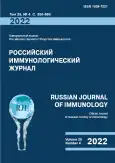Prognosis of COVID-19 outcomes and risk prediction for the development of post-COVID syndrome
- Authors: Atazhakhova M.G.1, Chudilova G.A.1, Nesterova I.V.1,2
-
Affiliations:
- Kuban State Medical University
- Peoples’ Friendship University of Russia
- Issue: Vol 25, No 4 (2022)
- Pages: 375-378
- Section: SHORT COMMUNICATIONS
- URL: https://journals.rcsi.science/1028-7221/article/view/120051
- DOI: https://doi.org/10.46235/1028-7221-1199-POC
- ID: 120051
Cite item
Full Text
Abstract
At the present time, the new laboratory diagnostic markers are required which may predict complications over the post-COVID period, as well as improve diagnostics of post-COVID syndrome in the patients who underwent COVID-19. Despite the fact that changes in respiratory system are the most common manifestations of COVID-19, extrapulmonary manifestations followed by the wide range of persistent symptoms and/or delayed complications may lead to multiple organ lesions of varying severity: from symptomless to fatal forms. A number of symptoms in the developed post-COVID syndrome may persist for > 3 weeks, or to be prolonged up to 6 months and later. The purpose of the study was to investigate the informativity of an early integrative diagnostic index developed by us, enabling prediction of the COVID-19 outcome, and potential development of early post-COVID syndrome.
Peripheral blood samples were examined in 60 patients (38-82 years old) diagnosed with COVID-19 of moderate severity (CT-2.3) during their inpatient treatment; 30 patients (38-62 years old) in the early post-COVID period and 34 patients (38-65 years old) with early post-COVID syndrome. The comparison group consisted of 100 healthy sex- and age-matched volunteers. The IDP, an integrative diagnostic index, was calculated as a marker including the ratio of the relative neutrophil-to-lymphocyte numbers, as well as the levels of C-reactive protein (CRP), by the following formule: IDP = (% neutrophilic granulocytes × CRP) / % lymphocytes.
We have found that, during the inpatient treatment, upon acute clinical manifestations, IDP in study group 1 was increased 12.5 times against the comparison group. It should be noted that all patients were discharged from the hospital in compliance with official criteria, according to Temporary Guidelines. In the study group 2, during early postcovid period, IDP remained 3.4-fold elevated against the comparison group. According to the chest CT data, the patients had signs of a fibrous component, organizing stage of pneumonia and consolidation foci in the lung tissue. Among the group 3 patients (early post-COVID syndrome), IDP was increased three-fold against the comparison group, accompanied by the documented signs of chronic fatigue syndrome and cognitive impairment.
The IDP can be used as a marker for the prognosis of clinical outcome and a predictor of the evolving complications during the early post-COVID period and upon development of early post-COVID syndrome in the patients who have undergone COVID-19.
Full Text
##article.viewOnOriginalSite##About the authors
M. G. Atazhakhova
Kuban State Medical University
Email: inesterova1@yandex.ru
Postgraduate Student, Department of Clinical Immunology, Allergology and Laboratory Diagnostics
Russian Federation, Krasnodar
G. A. Chudilova
Kuban State Medical University
Email: inesterova1@yandex.ru
PhD, MD (Biology), Associate Professor, Head, Department of Clinical and Experimental Immunology and Molecular Biology, Central Research Laboratory; Professor, Department of Clinical Immunology, Allergology and Laboratory Diagnostics
Russian Federation, KrasnodarI. V. Nesterova
Kuban State Medical University; Peoples’ Friendship University of Russia
Author for correspondence.
Email: inesterova1@yandex.ru
PhD, MD (Medicine), Professor, Chief Research Associate, Department of Clinical and Experimental Immunology and Molecular Biology, Central Research Laboratory; Professor, Department of Allergology and Immunology, Faculty of Continuing Medical Education
Russian Federation, Krasnodar; MoscowReferences
- Атажахова М.Г., Чудилова Г.А., Нестерова И.В. Новый интеграционный диагностический показатель – прогностический фактор исхода болезни у пациентов с COVID-19 // III объединенный научный форум физиологов, биохимиков и молекулярных биологов Научные труды. Т. 1. М.: Перо, 2021. С. 68. [Atazhakhova M.G., Chudilova G.A., Nesterova I.V. New integration diagnostic indicator – prognostic factor of disease outcome in patients with COVID-19. III Joint Scientific Forum of Physiologists, Biochemists and molecular Biologists. Scientific works. Vol. 1]. Moscow: Pero, 2021, p. 68. (In Russ.)]
- Белопасов В.В., Журавлева Е.Н., Нугманова Н.П., Абдрашитова А.Т. Постковидные неврологические синдромы // Клиническая практика, 2021. Т. 12, № 2. С. 69-82. [Belopasov V.V., Zhuravleva E.N., Nugmanova N.P., Abdzashitova A.T. Post-COVID-19 neurological syndromes. Klinicheskaya praktika = Journal of Clinical Practice, 2021, Vol. 12, no. 2, pp. 69-82. (In Russ.)]
- Белоцерковская Ю.Г., Романовских А.Г., Смирнов И.П., Синопальников А.И. Долгий COVID-19 // Consilium Medicum, 2021. Т. 23, № 3. С. 261-268. [Belotserkovskaya Yu.G., Romanovskikh A.G., Smirnov I.P., Sinopalnikov A.I. Long COVID-19. Consilium Medicum, 2021, Vol. 23, no. 3, pp. 261-268. (In Russ.)]
- Канорский С.Г. Постковидный синдром: распространенность и патогенез органных поражений, направления коррекции. Систематический обзор // Кубанский научный медицинский вестник, 2021. Т. 28, № 6. С. 90-116. [Kanorsky S.G. Postcovid syndrome: prevalence and pathogenesis of organ lesions, directions of correction. Systematic review. Kubanskiy nauchnyy meditsinskiy vestnik = Kuban Scientific Medical Bulletin, 2021, Vol. 28, no. 6, pp. 90-116. (In Russ.)]
- Костинов М.П., Шмитько А.Д., Полищук В.Б., Хромова Е.А. Современные представления о новом коронавирусе и заболевании, вызванном SARS-COV-2 // Инфекционные болезни: новости, мнения, обучение. 2020. Т. 9, № 2. С. 33-42. [Kostinov M.P., Shmitko A.D., Polishchuk V.B., Khromova E.A. Modern representations of the new coronavirus and the disease caused by SARS-COV-2. Infektsionnye bolezni: novosti, mneniya, obuchenie. Infektsionnye bolezni: novosti, mneniya, obuchenie = Infectious Diseases: News, Opinions, Training, 2020, Vol. 9, no. 2, pp. 33-42. (In Russ.)]
- Нестерова И.В., Городин В.Н., Чудилова Г.А., Чапурина В.Н., Матушкина В.А., Габдрахманова Р.Ю., Ломтатидзе Л.В., Ковалева С.В., Малиновская В.В., Семененко Т.А. Эффекты влияния рекомбинантного интерферона α-2b на фенотип субпопуляций нейтрофильных гранулоцитов пациентов с COVID-19 // Инфекционные болезни, 2022. Т. 20, № 1. С. 43-51. [Nesterova I.V., Gorodin V.N., Chudilova G.A., Chapurina V.N., Matushkina V.A., Gabdrakhmanova R.Yu., Lomtatidze L.V., Kovaleva S.V., Malinovskaya V.V., Semenenko T.A. Effects of recombinant interferon α-2b on the phenotype of neutrophil granulocyte subpopulations of patients with COVID-19. Infektsionnye bolezni = Infectious Diseases, 2022, Vol. 20, no. 1, pp. 43-51. (In Russ.)]
- Reusch N., de Dominico E., Bonaguro L., Schulte-Schrepping J., Babler K., Schultze J.L., Aschenbrenner А.С. Neutrophils in COVID-19. Front. Immunol., 2021, Vol. 12, 652470. doi: 10.3389/fimmu.2021.652470.
Supplementary files







